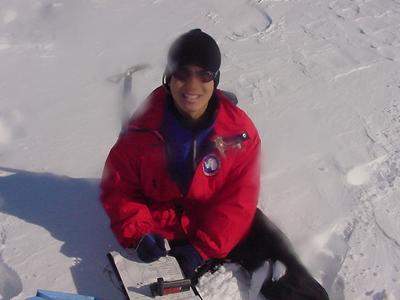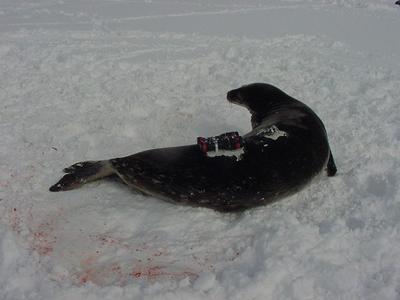27 November, 2000
FYI answer for 11/26/00
This time of year storms usually circle the continent offshore. There is not a clear understanding why the weather pattern at this time seems to be circling in over the ice shelf region now. Forecasters and researchers alike will be looking for the answer and how it may relate to weather patterns elsewhere in the world because of this here in Antarctica.
When Yoko had to leave, Katsu and I still needed a third person in order to continue the research work that he was here to do. We were able to get Elizabeth Morton from McMurdo's Berg Field Center to come stay out here and work with us last week. This week we have a general assistant named Gifford Wong who will be working with us. I had the opportunity to meet Gifford during my 'happy camper' survival training and sea ice training. He came to join us yesterday.
The sun was shining today, so we expected to try and catch up on the work that we've missed for the last five days. We still had one female seal at Turks Head that we had attached an instrument to last week. Our first task today was to find her, and luckily we did find her on the ice. We detached the data logger and completed the census at Turks Head. Unfortunately the winds were too strong to do the two attachments that Katsu wanted to do. We returned to Big Razorback to complete the daily census there, and the same problem of high winds made our day of sunny weather shorter than we wanted.
Today was also a census day, so Cory, Mike, Shawn and Dan were out early to do the study area census. The census days are now about every five days, when we have cooperating weather. We have had five censuses. The weather has put the census numbers behind by only one, but the number of trips out of the study area is what has been affected most. There have been only two trips ut of the study area, but by this time last year they had seen each area one time.
With the snows over the past week, walking out to the seals here at Big Razorback has been an exercise in high stepping. The bigger challenge, though, is the ice cracks. The ice cracks are getting wider and the snow over them is deeper. In some cases, it doesn't help to have the ice ax. It would be better to have a bamboo pole. Bamboo poles are used to flag the routes that are safe to travel. Teams go out on a regular basis to keep track of ice cracks and their changes. The routes are then marked every 40 meters, or 120 feet, by green or red fags attached to bamboo poles. When we travel back and forth to McMurdo, we follow the green flags. Black flags mark danger or hazards. We have yellow and orange flags marking our communication lines to the solar unit that are lying across the ice so we don't drive over them. The travel out to Barnes Glacier and Cape Royds is now becoming resricted because of the changes in the ice cracks in that area. I was just there about two weeks ago.
FYI
The McMurdo Galley served Thanksgiving dinner to 880 people. Here is a gathering of what they served and how much they served.
Pounds of meat: turkey; ______ ham 150; Antarctic cod 200; salmon 40
Gallons of gravy: 20
Number of rolls: ________
Pans of stuffing: _____
Pounds of onions: 24
Pounds of cheese: _____
Pounds of canned cranberry sauce: 200
Pounds of fresh fruit: 120
Desserts: ______ pies; 500 pecan tarts

This is Gifford

Another female, mother seal with data instruments and a camera
Contact the TEA in the field at
.
If you cannot connect through your browser, copy the
TEA's e-mail address in the "To:" line of
your favorite e-mail package.
|
